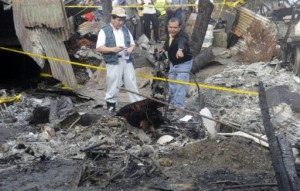The owner of the light plane that crashed into a Parañaque neighborhood last Saturday has surfaced and will appear in the investigation being conducted by the Civil Aviation Authority of the Philippines (CAAP), according to an aviation official.
Fidel Hembrador, the owner of the eight-seater Beechcraft Queen Air cargo plane, is expected to appear at CAAP office on December 21, said Captain Amado Soliman Jr., head of the investigating panel.
After a week of the Hembrador camp not being heard from, Hembrador’s lawyer, Jeffrey John Zarate, walked into the CAAP office yesterday to say that his client was still in the country and was ready to cooperate with the investigation. He was immediately served the subpoena for his client.
“We are glad that Mr. Hembrador, through his lawyer, has finally decided to surface,” said CAAP Director General Ramon Gutierrez.
Hold departure order
Hembrador, a former commercial pilot, owned the plane that crashed into a shanty community inside the Better Living subdivision in Barangay Don Bosco last Saturday, killing 14 people, including two pilots, a student pilot and residents of the shanty town.
Gutierrez said the CAAP is seeking a hold departure order (HDO) against Hembrador because of the latter’s failure to surface to face liability for the crash.
The CAAP’s move against the plane owner is being supported by Parañaque officials and families of the victims, according to Jun Virata, chair of Barangay Don Bosco.
“We heard he was planning to escape and go to the US,” said Virata.
Authorities, meanwhile, are focusing on possible engine failure as the possible cause of the crash, and are hoping to release their first “substantial” report on the incident by next week.
“The engine is being torn down at the authorized repair station (in Manila) to ascertain its condition,” said Soliman, head of the CAAP’s aircraft accident investigation inquiry board.
Amateur video
He also referred to an amateur video of the incident that has gone viral online. The video shows how the aircraft seemed to be out of control, flying low then rolling in midair before finally diving to the ground.
“You don’t have to be a pilot to see that something is wrong there. The weather was very calm,” said Soliman.
The CAAP has found that the aircraft owner had no air operator’s certificate (AOC), or license to fly, raising the possibility that the plane was operating “colorum” (unregistered).
“It looks like the plane was moonlighting and based on the flight plan, it was using the certificate of Aviation Technologies Innovators (ATI),” said Gutierrez.
He explained that ATI is a firm that is leased for aircraft maintenance and hangar arrangements. Further investigation showed the crashed plane has used ATI’s hangar and repair facilities, he said.
According to Gutierrez, the ATI admitted to having a verbal agreement with Hembrador for the use of the hangar as they are close friends.
He said ATI could face sanctions as its certificate was used in the fateful flight.
‘Human factor’
The CAAP is also not discounting the possibility that “human factor,” the politically correct term for pilot error, played a key role in the fatal crash.
He said the transcript of the conversation between the pilot and the air controllers would be reviewed for signs of the trouble that beset the ill-fated plane.
The last conversation released to the media showed that the pilot had declared an emergency and asked for a “re-landing.” He was given the go-signal to land, after which nothing more was heard from him.
According to Soliman, a retired pilot, a malfunctioning engine would require skillful maneuvering of the plane, especially when turning back towards the runway, so as not to aggravate an already bad situation.
Transportation Secretary Mar Roxas has directed the CAAP and the Manila International Airport Authority to provide financial assistance to the victims and the families who were affected by the crash. With Tarra Quismundo
